We set the scene: homeowners need clear, practical advice on glazing choices. This short guide shows where performance shines and where the extra cost may not pay back.
Comfort and cash matter. Improved thermal performance — lower U‑values around 0.6–0.8W/m²K versus 1.2–2.8 for double glazing — means fewer cold spots and steadier room temperatures. That can cut energy use, though actual energy bills and savings depend on baseline window quality and fuel prices.
Market uplift varies: some suppliers add 10–20%, others 30–50% over double systems. We weigh cost, embodied materials, acoustic gain and potential added value for homes. Then we map scenarios across regions and budgets so you can decide if the upgrade matches your aims and payback timeline.
Key Takeaways
- Triple glazing offers clear comfort and performance gains, but payback varies by home and energy prices.
- U‑value improvements reduce heat loss; real savings depend on existing frames and fuel rates.
- Price uplifts range widely — specification and supplier matter for cost and value.
- Acoustic reduction and perceived value can justify higher spend for some buyers.
- We provide scenarios ahead to help you match choices to your budget and timescale.
What UK homeowners really want to know in 2025
Decisions now hinge less on pane count and more on certified performance. The Energy Saving Trust and Building Regulations point to BFRC labels and minimum C‑ratings as the practical way to compare products.
We advise focusing on the whole system: frame, spacer, Low‑E coatings and gas fill. A top spec double glazing package can match the efficiency of some triple glazing setups. So check A to A++ BFRC ratings and warranties, not just a headline U‑value.
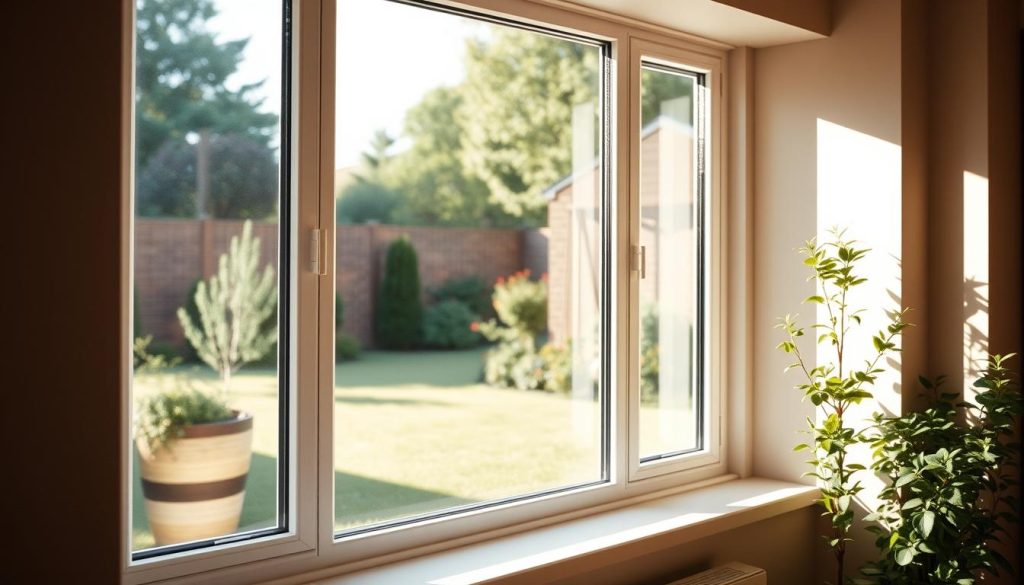
Think comfort as well as bills. Homeowners want warmer window reveals, fewer draughts and quieter rooms. Those benefits often show up faster in daily life than in monthly energy statements—especially in milder regions.
- Timing: replace when units fail or during refurbishments to cut disruption.
- Location: urban terraces and exposed rural homes need different specs.
- Resale: documented high‑performance upgrades can aid EPCs and marketing.
- Sourcing: compare like‑for‑like quotes — frame type and install quality change outcomes.
What is triple glazing and how does it work?
Think of this glazing as a thermal sandwich: three sheets of glass separated by two sealed, inert‑gas cavities. Those gas layers—commonly argon, with krypton or xenon on premium units—slow convection and conduction between indoors and out.
Construction matters. Warm‑edge spacer bars reduce heat loss around the perimeter. Low‑E coatings reflect room heat back inside in winter and trim unwanted infrared in summer. Together they lift U‑values into the 0.6–0.8W/m²K band versus typical double combos at 1.2–2.8W/m²K.
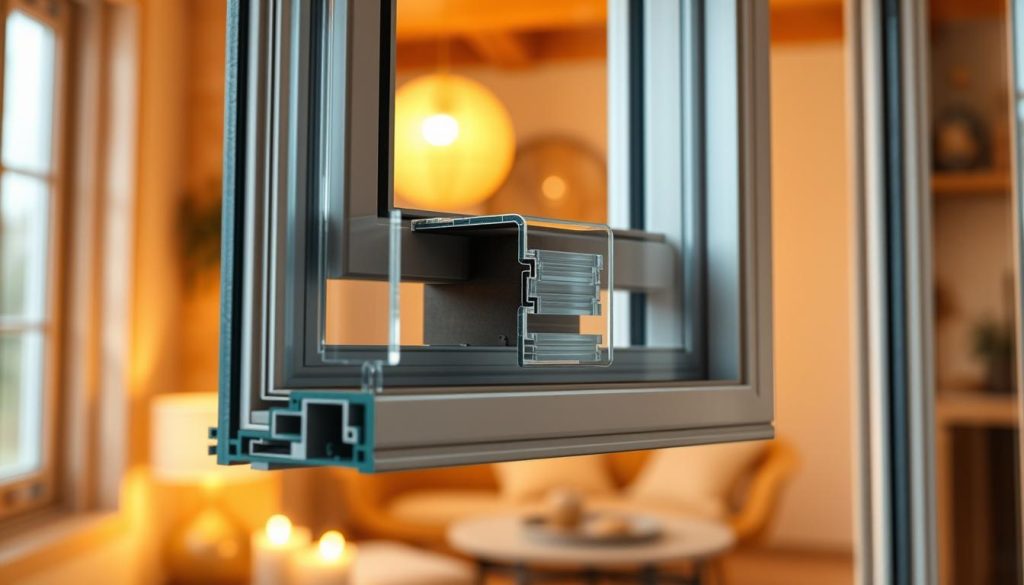
Ratings and real performance
BFRC labels (A++ to G) combine U‑value, air leakage and solar gain. Building Regulations require at least a C rating; A+ is attainable with high‑spec double or triple systems. That means pane count alone is not the final answer—verified ratings are.
| Feature | Common option | Effect on performance |
|---|---|---|
| Gas fill | Argon (standard) | Good balance of cost and insulation |
| Spacer | Warm‑edge | Reduces edge conduction and condensation risk |
| Coating | Low‑E | Improves winter retention and summer control |
| Manufacture | Tight tolerances | Ensures rated performance on installation |
- Correct cavity width and seals are as crucial as that extra pane glass.
- System thinking wins: frame, spacer and install quality define final comfort and insulation.
Triple glazing vs double glazing: performance you can feel
Small changes in U‑value and solar gain produce effects you can sense daily. We compare how a lower U‑value and a different G‑value alter room comfort, noise and condensation.
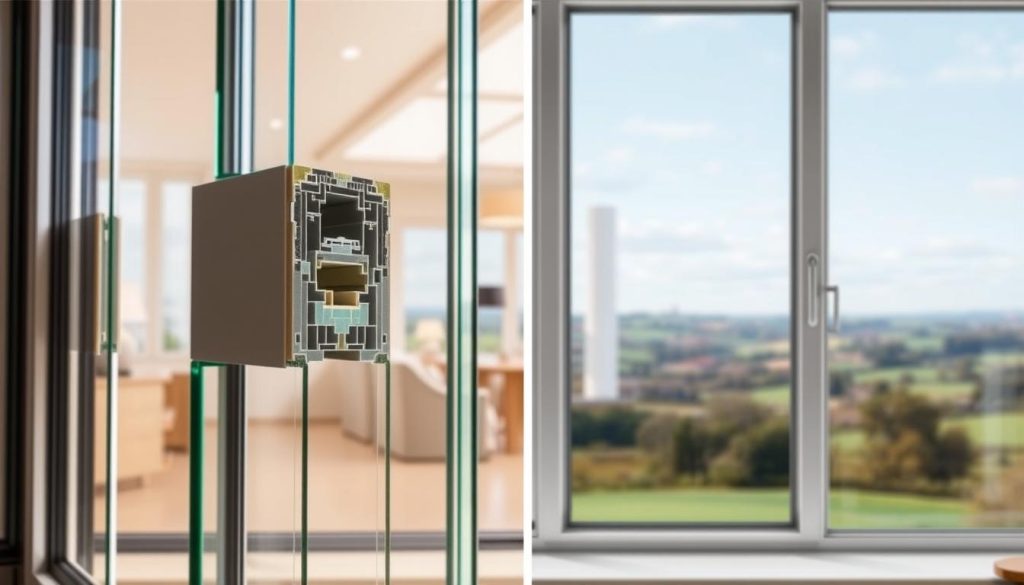
U‑values and G‑values explained
U‑value measures heat flow: 0.6–0.8W/m²K for triple glazing versus roughly 1.2–2.8 for double glazing. Lower numbers mean less heat loss and better insulation.
G‑value is solar gain. Typical figures sit near 0.46 for triple and about 0.78 for double. A lower G‑value tempers summer heat peaks.
Heat loss and winter comfort near the window
At the same thermostat setting, inner pane temperature can be about 18°C with triple and 16°C with double. Those two degrees cut downdraughts and make seating near the glass feel warmer.
Summer overheating and solar gain management
Higher solar gain helps passive heating in winter but can cause overheating in south‑facing rooms. Choose glazing based on aspect and shading to balance winter warmth and summer control.
Noise reduction and soundproofing
Adding a pane and varying glass thickness can deliver up to ~10 dB extra noise reduction compared with double glazed units. For heavy traffic or rail noise, laminated and asymmetric panes add real benefit.
Condensation and indoor humidity control
Warmer inner glass keeps surface temperatures above dew point more often. That reduces morning misting and the mould risk on reveals. Good seals and ventilation complete the fix.
- Quantified gap: lower U‑values cut conductive heat loss.
- Comfort: warmer reveals and fewer cold drafts near the sofa.
- Trade‑offs: double glazed units admit more solar heat; extra pane often evens temperatures.
- Security: more layers improve resistance when paired with robust frames and locks.
Costs in the UK and realistic payback
Costs vary widely, but a clear pattern links frame type and glass spec to final price. We break the numbers down so you can plan realistically.
Typical price ranges per window (indicative, excluding install): uPVC £390–£2,025; aluminium £950–£3,525; timber £585–£3,350. Examples: uPVC casement ~£680, tilt & turn ~£845, aluminium casement ~£1,375, timber casement ~£2,050, sash ~£3,050, bay (three sections) ~£6,750.
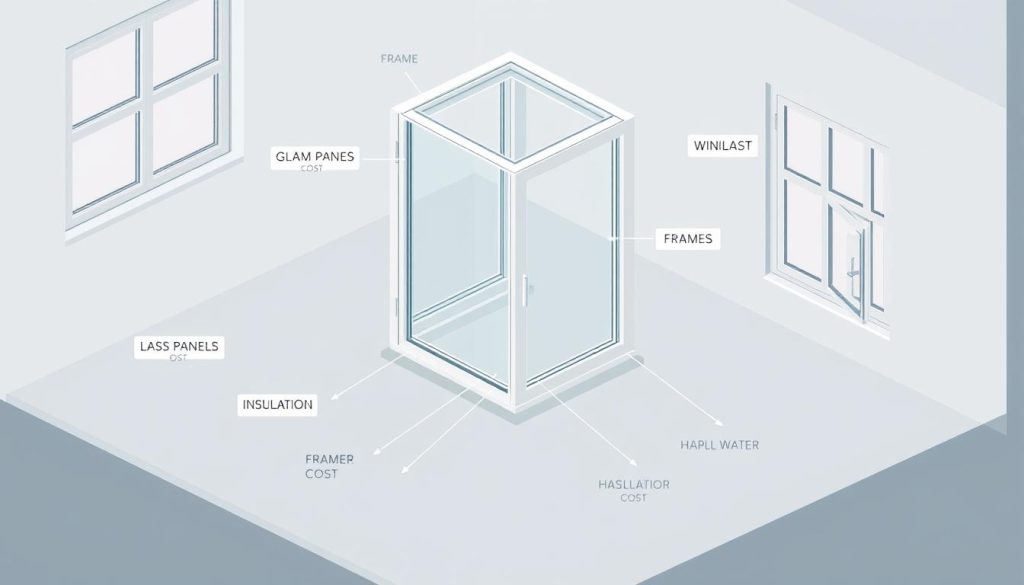
Why quotes differ
Size, opener count and hardware change labour time. Glass spec, gas fill and warm‑edge spacers alter manufacturing cost.
Site conditions—scaffold, lintels, access—and make‑good works swing totals more than most expect.
Payback and finance
Uplifts over double glazing range 10–20% to 30–50% depending on spec. A retrofit example: full 5‑bed refit £10,600 vs £7,460 — a £3,140 delta with ~922kWh saved (~£50/yr) in one model. That implies long payback in mild homes.
Under some tariffs, moving from strong double to higher spec glazing can save >£200/yr. Electric heating shortens cash payback versus standard gas tariffs.
Timing tip: align replacement with refurbishments to share labour and decoration costs.
- Budget bands: uPVC entry, aluminium mid, timber top end.
- Finance: staged payments reduce upfront strain—compare interest to expected savings.
- Soft gains: better security, fewer maintenance call‑outs and improved comfort often arrive immediately.
Where in the UK does triple glazing make the most sense?
Location changes the maths: cold, windy sites and noisy roads shift the balance in favour of higher‑performance glazing.
In northern and exposed coastal areas — think northern Scotland and high moorland — lower temperatures and harsher weather increase the thermal upside. During long winter spells, extra insulation keeps interior surfaces warmer and reduces heating demand.
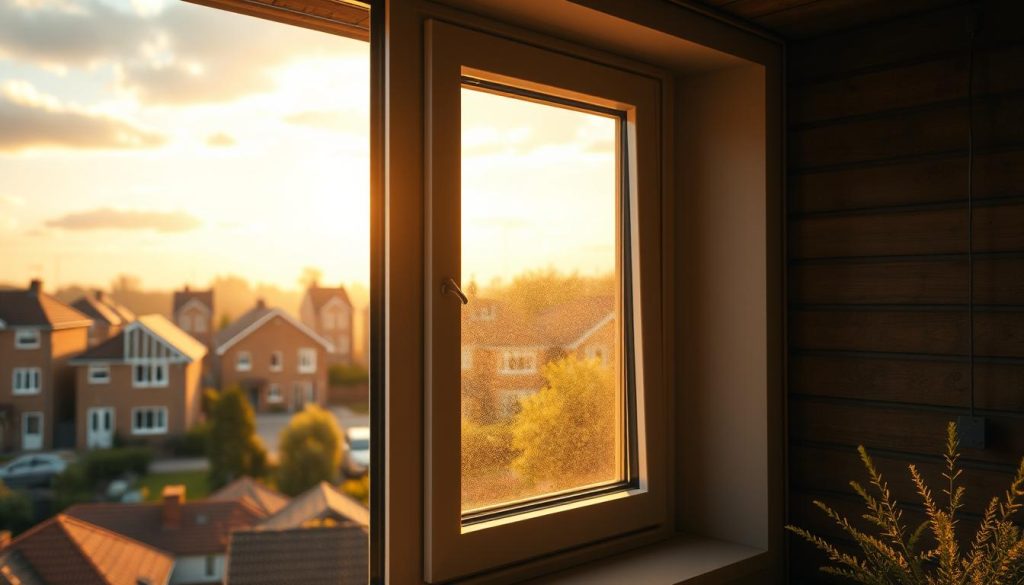
Colder climates and noisier locations
Homes facing A‑roads, rail corridors or flight paths gain real life quality from improved sound damping. The added layers cut night noise and make living rooms quieter.
New builds, extensions and high‑performance envelopes
For new windows in extensions or Passivhaus‑level projects, integrating deeper frames and wider cavities is cheaper per unit. If you aim for U‑values ≤0.8W/m²K, high‑spec glazing is the practical route.
- Orientation: south‑facing, heavily glazed rooms may benefit from lower solar gain to avoid summer peaks.
- Southern sheltered homes: modern A‑rated double glazing can be sufficient unless sound or comfort at the glass is a priority.
- Security and resilience: robust sealed units add deterrence and help protect against severe weather.
Triple glazed windows: the key pros and cons
Weighing benefits and trade-offs helps homeowners choose the right glazing for their home and budget. The extra pane provides measurable gains, but it is not universally best.
The advantages
Better insulation: Up to 40–50% improved thermal performance compared compared double packages. Less heat loss means warmer indoor surfaces and fewer cold spots.
Reduced condensation and comfort: Warmer inner glass cuts misting and mould risk. That improves living comfort through winter months.
Noise and security: Mixed-thickness panes and laminated glass lower noise by up to ~10 dB. More layers plus toughened options also raise security margins.
The drawbacks
Higher upfront cost: Expect a 10–20% to 30–50% uplift over many double glazed choices. Frames, hardware and install complexity drive price.
Weight and structure: Extra glass adds load. Older frames or delicate openings may need reinforcement or a survey before fitting.
Solar gain and embodied carbon: Lower G-values reduce passive winter heat in shaded homes. Manufacture carries higher embodied carbon—often 40–50% more—though lifetime energy savings can offset this.
- Summary: If quiet, steady temperatures and added security matter, the non-monetary value can justify the premium.
- Otherwise: High-spec double options may deliver similar energy efficiency for less cost in many UK locations.
Specifications that change performance and price
We recommend thinking of specification as a recipe: the right mix of frame, gas and glass determines final comfort and cost.
Frames: uPVC, aluminium and timber trade‑offs
uPVC keeps purchase and maintenance costs low and suits many retrofit jobs. Aluminium offers slim sightlines and long life but costs more. Timber gives authentic style for period homes — expect higher purchase and upkeep costs.
Gas fills: argon as standard, krypton/xenon for higher performance
Argon is the pragmatic choice for value and insulation. Krypton or xenon improve U‑values and sound damping but raise material and manufacturing cost. Choose rare gases only when tight certification or minimal cavity widths demand them.
Glass options: Low‑E coatings, thickness, laminated and acoustic glass
Low‑E coatings reduce winter heat loss and limit summer solar gain. Mixed thickness panes and laminated layers boost sound reduction and security. Warm‑edge spacers and good seals lift whole‑window insulation more than chasing centre‑of‑glass numbers alone.
Design styles: casement, tilt and turn, sash and bay
Casement offers best value and ventilation. Tilt & turn brings easy cleaning and safety at a premium. Sash and bay suit character properties but add complexity and cost — think structure and decoration when budgeting.
- Practical tip: match specification to the problem — prioritise soundproofing near roads, low solar gain for south aspects and higher insulation on exposed elevations.
- Cost check: example prices — uPVC casement ~£680; uPVC tilt & turn ~£845; aluminium casement ~£1,375; timber casement ~£2,050; timber sash ~£3,050; timber bay ~£6,750.
- Summary: invest where marginal gains matter; avoid over‑specifying where the extra cost won’t pay back in comfort or performance.
are triple glazed windows worth it UK: honest scenarios
The right upgrade is a mix of targeted replacements, soft measures and measured specification. We start with the problem you face: cold spots, traffic noise or a high‑performance target. That tells us whether higher‑spec glazing or an alternative is best.
When to choose higher‑spec glazing over modern A‑rated double glazing
If you need U≤0.8W/m²K across the envelope, live on a busy road or face exposed, cold elevations, pick the better sealed option. In such homes the gains in insulation, sound and surface temperature justify the premium.
Smart alternatives: secondary glazing, blinds and targeted upgrades
Not every house needs a full replacement. Secondary glazing with a ~100mm gap and acoustic glass often beats standard units for soundproofing and suits listed homes.
- Targeted approach: prioritise north and traffic‑facing facades and bedrooms.
- Low cost wins: lined curtains and tight blinds cut night‑time heat loss.
- Security: laminated panes and better locks give protection without full over‑spec.
- Modelling: run heat loss and tariff scenarios — savings range from ~£50 to >£200 per year depending on baseline.
“Decide on the upgrade that fixes your real problems — not the one with the highest pane count.”
Planning, regulations and practical constraints
Permissions, structure and listed‑building rules often decide a project long before quotes land on your desk.
Check designations first. In conservation areas (Article 2(3)) or where Article 4 directions apply, local planning permission may be required. Listed properties need Listed Building Consent before any replacement of glazed units.
Heritage and alternatives
Secondary glazing is often the fastest route in protected façades. It keeps façades intact while improving insulation and sound control.
Structural checks and costs
Older apertures were sized for single panes. A heavier triple glazing unit can need lintel or sill reinforcement.
Factor in disposal, making good and possible plaster or decorator work. These hidden costs can outpace the glass cost delta.
Compliance and future‑proofing
Building Regulations demand minimum energy performance; BFRC ratings and installer certification ease approvals.
Security and safety: specify laminated glass in reachable openings and confirm hardware meets PAS 24 where relevant.
“Plan permissions and structure first — specification follows the constraints, not the other way round.”
Conclusion
If comfort, noise control or low U‑values drive your brief, upgrade choices become clearer.
We conclude that triple glazing makes sense when climate, traffic or a high‑performance target demand lower heat loss and better sound control. In those cases the improved insulation and calmer rooms deliver clear value and quieter living.
Be honest about payback: costs sit 10–20% to 30–50% above many double glazing options, with possible savings from ~£50/yr to over £200/yr depending on baseline, tariff and exposure.
Prioritise BFRC ratings, whole‑system specification (frames, spacers, gas and Low‑E glass) and install quality. Where permissions or budget bite, choose secondary glazing or room‑by‑room upgrades.
Final thought: pick the specification that fixes your real problems. Quiet, warm and secure rooms are the return you feel every day — and for years.



